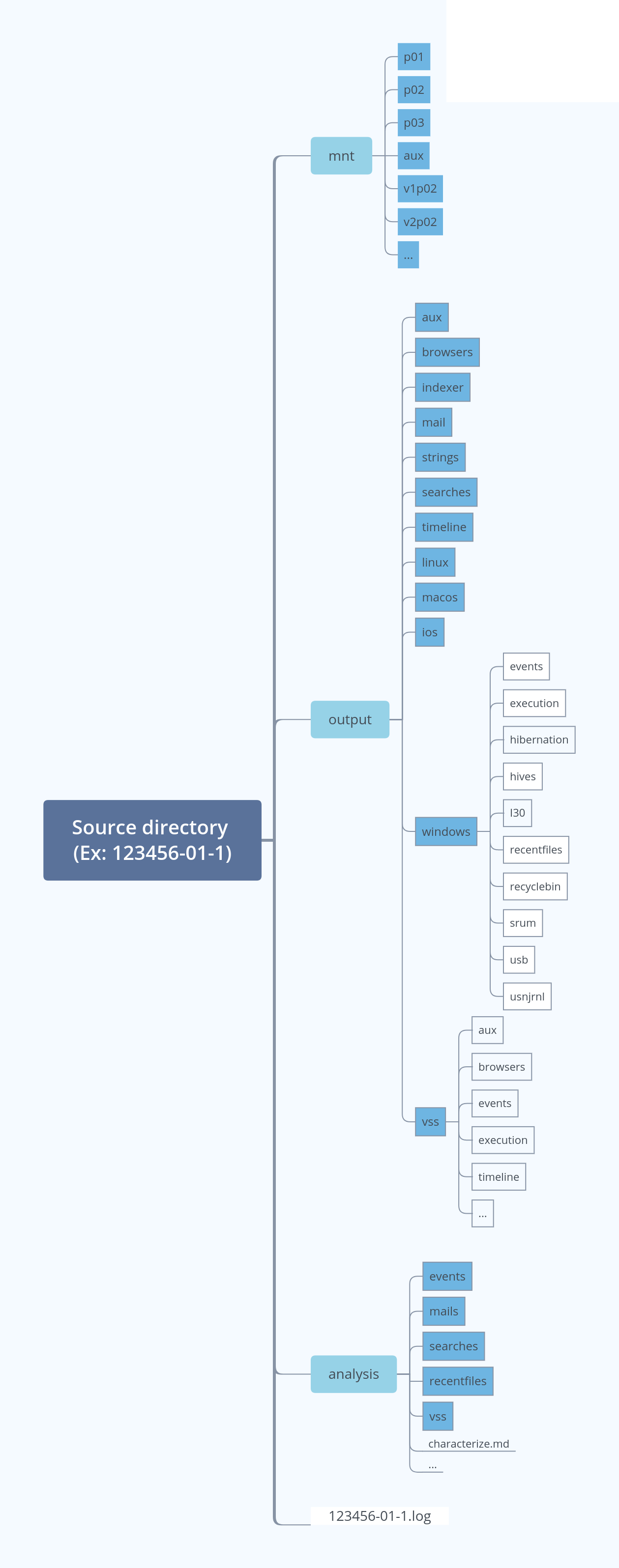# Folder structure
The Revealer Toolkit2 defines its own structure to organize the forensic cases. The main folder is refered as the morgue, and stores all the disk images and results of forensic analysis.
RVT2 can handle more that one morgue. By default, one morgue is defined at the location /morgue.
The morgue location, as well as its subfolders, can be custom defined within configuration files. However, some RVT modules rely on a predefined structure that allows to correlate differents forensics artifacts easily. It is advisable not to modify the structure beyond the morgue location itself and the images location.

# Cases
Each forensic case is by default determined by a case number and a case codename, separated by a dash. For example, 100101-ghost.
Each case has a folder assigned in the morgue, where all the forensic data is stored for each source.
# Sources
Under the Revealer Toolkit2, information sources are organized with:
- Devices: each case has a number of devices: computers, cell phones, digital cameras, ... They are numbered sequencially from 01 to 99.
A device is named as casenumber-devicenumber, for example, 100101-01 for the case 100101 and device 01. - Disks: each device has a number of disks: hard disks, CD’s, memory cards, ... They are numbered sequencially from 1 to 9.
A disk is named as case-device-disknumber, for example, 100101-01-1, for the disk 1
# Images
The disk images are stored, in raw format, in a designed folder for every case inside the directory images.
# Source directory structure
The Revealer Toolkit2 manages and executes modules, which performs forensic operations on the disk images and disk information. All these forensic results are stored in the source directory the image is associated to. Each source generates three main folders: mnt, output and analysis.

# mnt
Location where disk partitions are mounted. Contents of each partition are stored in subfolders like p03, following the numeration used by the Sleuthkit command mmls.
Partitions with Windows filesystems may contain VShadow Snapshots. These are mounted with names such as v2p03, which in this case indicates the second vshadow snapshot of partition 3.
Some partitions requiere auxiliary mounting points (using mounted fusedevices with bindfs, vshadowmount or dislocker), and are stored inside aux subfolder. The contents still can be found in the subfolder corresponding to the partition name.
# output
Main folder with the results of automated extraction of various artifacts.
# output/timeline
Timeline for the all files found in every partitions of a disk (VShadow Snapshots excluded). The documents show paths, timestamps and other metadata associated to every file found in the filesystem.
# /output/browsers
Information about history, downloads, cookies, ... for all browsers found in every partition.
# output/indexer
Documents indexed in order to be used by searching services, such as Elastic.
# output/mail
Parsed data of mails found in disk, either individual or contained in bigger mail structures such as pst.
# output/string
Relation of all printable character sequences found in disk, also in the slack space.
# output/searches
Results of keyword searches against strings
# output/ios
Documents specifically related to IOS systems.
# output/linux
Documents specifically related to Linux systems.
# output/macos
Documents specifically related to MacOS systems.
# output/windows
Documents specifically related to Windows systems.
# output/windows/events
Information extracted from Windows event logs
# output/windows/execution
Information extracted from Windows artifacts such as prefetch, bam or rfc, associated with program and services executions.
# output/windows/hives
Information extracted from registry hives. Output files are organized depending on the type of information or hive parsed.
# output/windows/hibernation
Information obtained from hiberfil.sys.
# output/windows/i30
Parsing of I30 Index attributes, both in allocated and slack space.
# output/windows/recentfiles/
Information related to jumplists and lnk files found in disk.
# output/windows/recyclebin
Information about files found in RecycleBin.
# output/windows/srum
Information from the System Resource Usage Monitor (SRUM)
# output/windows/usb
Specific usb artifacts information, like usb_setupapi. More information on usb devices can be found in the registry and is stored under output/windows/hives.
# output/windows/usnjrnl
Folder with NTFS Journal dump, and a filter with ended journal processes.
# output/vss
All the information extracted from VShadow Snapshots. Follows a substructure based on output and windows folders. These subfolders contain the same information previously described, but applied only to VShadow Snapshots found.
# analysis
Contain general reports and other documents with selected information about different artifacts. This is a start point for analysis, since the reports are more descriptive than the raw information they are based on, found in output directory.
# analysis/events
Series of filtered information reports for some event logs.
# analysis/mails
Relation of metadata information about all mails found in disk.
# analysis/recentfiles
Documents containing selected data from jumplists and lnk files.
# analysis/searches
Location of pdf files describing the full results of searches against strings.
# Log file
RVT2 stores by default the logs of all executed jobs in a directory
${sourcedir}/log. The filename is the job identifier.
In addition, a list of the already executed jobs and their status can be found
at ${casedir}/rvt2.jobs.json. You can also access to this information using
the job status.